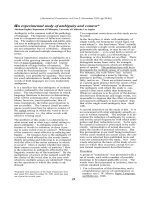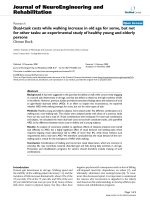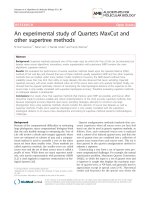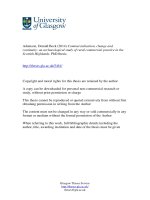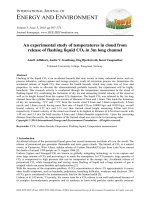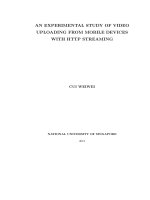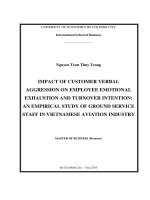An experimental study of pressure drop characteristics in vertical upward two phase and three phase flows
Bạn đang xem bản rút gọn của tài liệu. Xem và tải ngay bản đầy đủ của tài liệu tại đây (6.78 MB, 115 trang )
AN EXPERIMENTAL STUDY OF PRESSURE DROP CHARACTERISTICS
IN VERTICAL UPWARD TWO PHASE AND THREE PHASE FLOWS
SRI SAILA MALLIKARJUNAN KUTTUVA RAMALINGAM
VIJAYAKUMAR
(B.Eng., Anna University)
A THESIS SUBMITTED FOR THE DEGREE OF MASTER OF ENGINEERING
DEPARTMENT OF MECHANICAL ENGINEERING
NATIONAL UNIVERSITY OF SINGAPORE
2014
ACKNOWLEDGEMENTS
It is my pleasure to express my sincere appreciation and gratitude to my
supervisors, Prof. Nhan Phan-Thien and Prof. Khoo Boo Cheong for their able
guidance throughout the course of my research work. Their wise counsel and
consistent support during my study helped me to transform into an independent
researcher.
I wish to thank Dr. Lin Yuan, Dr. Hien Luong and Dr. Karri Badarinath for
guiding me in handling the rheometer and high-speed camera without which this
research work would have been impossible.
I wish to thank Assoc. Prof. Lim Siak Piang and Assoc. Prof. S H Winoto for
appointing me as their Graduate Tutor, which helped me in honing my
interpersonal skills and financially supporting my Masters’ Program.
I am also indebted to all staff of Fluid Mechanics lab II especially Mr. Yap, Mr.
Tan, Ms. Cheng Fong and Ms. Iris for their help during my experimental work.
I would like to thank my parents and my roommates for providing me a conducive
environment to work.
ii
Table of Contents
Abstract
vii
List of Tables
viii
List of Figures
ix
List of Symbols
xiii
1. Introduction
1
1.1. Multiphase flow-General
1
1.2. Background of the study
1
1.3. Problems associated with multiphase flows
2
1.3.1. Slugging
3
1.3.2. Pressure drop in pipelines
4
1.4. Objectives of current work
5
1.5. Scope of the current work
5
1.6. Organization of the thesis
6
2. Literature Review
7
2.1. Flow regimes in vertical conduits
7
2.1.1. General characteristics of slug flow
8
2.1.2. General characteristics of churn flow
9
2.2. Flow pattern map for vertical gas-liquid flow
9
2.3. Experimental studies on multiphase flow
10
2.4. Viscosity prediction models
11
2.5. Phase inversion prediction models
16
iii
2.6. Pressure drop prediction models
19
3. Experimental Facility, Material, Equipment and Instrumentation
24
3.1. Experimental test loop
24
3.2. Equipment
27
3.2.1. Materials
27
3.2.2. Flow meter
27
3.2.3. Pump
28
3.2.4. Mechanical homogenizer
28
3.2.5. Differential pressure transducer
29
3.2.5.1.
Calibration of pressure transducer High-speed camera
30
3.3. High-speed camera
31
3.4. HAAKE MARS III Rheometer
32
3.5. Experimental procedure
34
4. Experimental Results and Discussion
36
4.1. Rheological characterization of emulsions
36
4.2. Results of two phase flow experiment
37
4.2.1. Significance of hydrostatic and frictional pressure drop in two
phase system
42
4.2.2. Wall shear stress for two phase liquid-liquid system
43
4.2.3. Wall shear rate for circular pipes
46
4.2.4. Friction factor for two phase liquid-liquid system
52
4.3. Results of three phase flow experiment
4.3.1. Results of three phase slug flow experiment
iv
55
56
4.3.1.1.
Slug flow visualization using high-speed camera
61
4.3.1.2.
Slug length
66
4.3.1.3.
Bubble rise velocity
67
4.3.1.4.
Slug frequency
69
4.3.2. Identification of churn flow regime
4.3.2.1.
Results of three phase churn flow experiment
4.3.3. Comparison of results of slug flow and churn flow regime
5. Conclusion and Future work
71
74
76
78
5.1. Summary
78
5.2. Recommendations for future work
80
References
81
Appendix
88
Appendix A: Experimental setup (top)
88
Appendix B: Experimental setup (bottom)
89
Appendix C: Pressure loss data sheet for non-return valve
89
Appendix D: Moody’s Chart
90
Appendix E: Time history of slug flow experiment (60% oil concentration; (a)
Vsg = 0.339 m/s; (b) Vsg = 0.509 m/s)
91
Appendix F: Time history of slug flow experiment (60% oil concentration; (a)
Vsg = 0.679 m/s; (b) Vsg = 0.849 m/s)
92
Appendix G: Time history of slug flow experiment (70% oil concentration; (a)
Vsg = 0.339 m/s; (b) Vsg = 0.509 m/s)
v
93
Appendix H: Time history of slug flow experiment (70% oil concentration; (a)
Vsg = 0.679 m/s; (b) Vsg = 0.849 m/s)
94
Appendix I: Time history of slug flow experiment (80% oil concentration; (a)
Vsg = 0.339 m/s; (b) Vsg = 0.509 m/s)
95
Appendix J: Time history of slug flow experiment (80% oil concentration; (a)
Vsg = 0.679 m/s; (b) Vsg = 0.849 m/s)
96
Appendix K: Time history of slug flow experiment (90% oil concentration; (a)
Vsg = 0.339 m/s; (b) Vsg = 0.509 m/s)
97
Appendix L: Time history of slug flow experiment (90% oil concentration; (a)
Vsg = 0.679 m/s; (b) Vsg = 0.849 m/s)
98
Appendix M: Time history of churn flow experiment (60% oil concentration;
Vsl = 0.245 m/s (a) Vsg = 1.359m/s; (b) Vsg = 2.038 m/s)
99
Appendix N: Time history of churn flow experiment (60% oil concentration;
Vsl = 0.245 m/s (a) Vsg = 2.718 m/s; (b) Vsg = 3.397 m/s)
vi
100
ABSTRACT
The flow of multiphase mixture is encountered in numerous industrial, energy
transfer process and especially in oil and gas transportation sector. Transportation
of multiphase oil and gas mixture form wellbore to onshore production facility
has many issues associated with it. One of the main issues associated with
multiphase transportation is pressure drop. In this current work, a small scale
three phase test loop was designed and constructed. The test loop is capable of
conducting two phase (liquid-liquid) and three phase (liquid-liquid-gas) pressure
drop measurement in vertical pipe. The two phase pressure drop experiment was
conducted focusing on the phase inversion phenomenon. The three phase pressure
drop experiment was conducted in slug flow and churn flow regimes and the
effects of gas superficial velocity on the components of pressure drop (frictional
and hydrostatic) was examined. Flow visualization technique using high-speed
camera is used for identification of flow regime and to deduce essential
information such as slug length, bubble rise velocity and slug frequency.
Rheological characterization of emulsion sample for different oil concentration
was performed using HAAKE MARS III Rheometer.
vii
List of Tables
Table 1.1 Commonly followed slug mitigation practices and their drawbacks
4
Table 3.1 Calibration table for pressure transducer
31
Table 3.2 Flow rate specification for present experimental study
35
Table 4.1 Wall shear rate values for various flow rates and concentration
48
Table 4.2 Evaluation of phase inversion prediction models
51
Table 4.3 Comparison of friction factor
53
viii
List of Figures
Fig. 2.1
Gas-liquid flow regimes in vertical pipes
Fig. 2.2
Flow pattern map for vertical gas-liquid flow presented by
Taitel et al.
Fig. 2.3
10
Schematic illustration of the process of non-Newtonian
emulsion formation as described by Pal and Rhodes
Fig. 2.4
8
14
Phase inversion process in oil-water system as described by
Arirachakaran et al.
17
Fig. 3.1
Schematic of three phase test loop facility
Fig. 3.2
The constant C relationship between Re and ratio of
development length and pipe diameter
25
26
Fig. 3.3
Performance curve of flexible impeller pump
28
Fig. 3.4
Wiring diagram of pressure transducer
30
Fig. 3.5
Calibration graph for pressure transducer
31
Fig. 3.6
Photron FASTCAM High-speed camera
32
Fig. 3.7
HAAKE MARS III Rheometer
34
Fig. 4.1
Rheogram of emulsion of different concentration at T = 28oC
36
Fig. 4.2
Plot of frictional pressure drop vs flow rate for different
emulsion concentration
Fig. 4.3
38
Plot of frictional pressure drop vs different emulsion
concentration for different flow rate
ix
39
Fig. 4.4
Plot of piezometric pressure drop vs flow rate for different
emulsion concentration
Fig. 4.5
41
Plot of piezometric pressure drop vs different emulsion
concentration for different flow rate
Fig. 4.6
Components of two phase pressure drop at Um = 1.61 m/s
Fig. 4.7
A schematic of cylindrical fluid element depicting various
forces acting on it
Fig. 4.8
42
44
Plot of wall shear stress vs flow rate for different emulsion
concentration
Fig. 4.9
41
45
Plot of wall shear stress vs different emulsion concentration
for different flow rate
45
Fig. 4.10 Plot of ln (τw) vs ln (ξ)
46
Fig. 4.11 Plot of apparent viscosity (estimated from Eq. 4.8 and Eq.
4.10) vs flow rate for different emulsion flow rate
49
Fig. 4.12 Plot of apparent viscosity (estimated from Eq. 4.8 and Eq.
4.10) vs emulsion concentration for different emulsion flow rate
49
Fig. 4.13 Plot of apparent viscosity (estimated from the rheometer) vs
flow rate for different emulsion flow rate
50
Fig. 4.14 Plot of apparent viscosity (estimated from the rheometer) vs
emulsion concentration for different emulsion flow rate
51
Fig. 4.15 Variation of friction factor with respect to oil concentration
53
Fig. 4.16 Variation of friction factor with respect to mixture velocity
54
x
Fig. 4.17 Varition of friction factor w.r.t mean velocity from Madjid et
al.
55
Fig. 4.18 Effect of liquid superficial velocity on total pressure drop for
different oil concentrations
58
Fig. 4.19 Different zones in slug flow regime as described by Ghosh
and Cui
59
Fig. 4.20 Effect of gas flow rate on frictional pressure drop in slug
flow regime
59
Fig. 4.21 Effect of oil concentration on frictional pressure drop in slug
flow regime
60
Fig. 4.22 Effect of liquid superficial velocity on frictional pressure
drop for different oil concentrations
61
Fig. 4.23 Slug flow visualization in viscous liquid (Vsl = 0.244 m/s)
62
Fig. 4.24 Slug flow visualization in viscous liquid (Vsl = 0.509 m/s)
63
Fig. 4.25 Slug flow visualization in viscous liquid (Vsl = 0.733 m/s)
64
Fig. 4.26 Slug flow visualization in viscous liquid (Vsl = 0.937 m/s)
65
Fig. 4.27 Effect of gas superficial velocity on slug length in viscous oil
66
Fig. 4.28 Effect of liquid superficial velocity on slug length in viscous
oil
67
Fig. 4.29 Effect of gas superficial velocity on bubble rise velocity in
viscous oil
68
Fig. 4.30 Effect of liquid superficial velocity on bubble rise velocity in
viscous oil
69
xi
Fig. 4.31 Effect of gas superficial velocity on slug frequency in
viscous oil
70
Fig. 4.32 Variation of slug frequency w.r.t gas superficial velocity as
reported by Tronconi
70
Fig. 4.33 Effect of liquid superficial velocity on slug frequency in
viscous oil
71
Fig. 4.34 Postulated mechanism of churn flow
72
Fig. 4.35 Churn flow visualization-downwash for Vsl = 0.244 m/s
73
Fig. 4.36 Churn flow visualization-up wash for Vsl = 0.244 m/s
74
Fig. 4.37 Effect of gas flow rate on frictional pressure drop in churn
flow regime
75
Fig. 4.38 Effect of oil concentration on frictional pressure drop in
churn flow regime
75
Fig. 4.39 Variation of components of pressure drop w.r.t gas flow rate
in slug flow regime
76
Fig. 4.40 Variation of components of pressure drop w.r.t gas flow rate
in churn flow regime
77
xii
List of Symbols
– relative viscosity
– volume fraction of dispersed phase
K - ratio of dispersed phase viscosity to continuous phase viscosity
– maximum packing fraction of dispersed phase
– oil holdup at inversion point
µ - dynamic viscosity of oil phase
ρ - density
D – internal diameter of pipe
Co, Cw, no, nw - parameters from Blasius friction factor equation
d32 – Sauter mean diameter
s – wetted perimeter
θ – water wettability angle
σ - oil–water interfacial tension
χ – Lockhart-Martinelli parameter
– pressure gradient
f - friction factor
GT – mass velocity based on total flow rate of liquid plus gas
R – local volume fraction of liquid
є – volume fraction of oil phase
xiii
– wall shear stress
– wall shear rate
Q – volume flow rate
̇ – multiphase mixture quality
Subscript
o – oil phase
w – aqueous phase
m – oil-water mixture
L – liquid phase
G – gas phase
T – Total
B – body force
f – friction force
xiv
Chapter 1
Introduction
1.1 Multiphase flow - general
In general a fluid flow can be classified into two broad types based upon the
number of immiscible phases that are considered into study: single phase flow and
multiphase flow. A single phase flow is the one in which the entire flow is
composed of same fluid whereas a multiphase flow is the simultaneous flow of
materials with different phases or materials with different physical properties but
in the same state such as in liquid-liquid systems (emulsions). In some cases, the
system although composed of more than one phase can be treated as
homogeneous and some properties can be averaged in a simple manner in such a
way that it is most widely accepted. However in nature and in a multitude of other
settings, the flow is multiphase such as air flow in the atmosphere in which
particulate suspensions are dispersed in a random fashion wherein the system can
be treated as a single phase system and in some cases like blood flow in veins,
mere approximation into single phase approximation leads to a Newtonian fluid,
whereas the suspension may display some viscoelastic properties, for example.
1.2 Background of the study
Multiphase pipeline flows are frequently encountered in oil and gas
transportation, fluidized bed reactors, refrigerant coils, scrubbers, dryers, etc.
Multiphase pipeline flow is often characterized by the flow of liquids and gases
1
Chapter 1: Introduction
simultaneously. In some scenarios, suspended particles (sand grains) may also be
carried along the fluid flow. During the early stages of a production well, the well
produces single phase crude oil however, within a short span of production life,
the well starts to produce water and natural gas along with the crude oil. Thus if
the multiphase flow mechanics are well understood, subsea production from
satellite installation and subsequent transportation of unprocessed oil and gas to
nearby platforms or directly to onshore facilities could be handled more
appropriately.
For depleting oil wells, where the natural reservoir pressure is insufficient to drive
the crude oil to the surface, artificial lift techniques such as gas lift technique is
employed to recover the oil from the reservoir. The power required to lift oil,
optimal gas injection pressure and flow rate can be predicted within acceptable
range of accuracy if the pressure drop profile of the gas lift well is known before
handed (Tek (1961)).
1.3 Problems associated with multiphase flows:
Problems associated with the simultaneous flow of two or more phases in
transport pipeline are of long standing interest in the oil and gas transport
industry. Some of the common problems associated with multiphase
transportation are slugging, hydrate formation, unpredictable pressure drop during
flow, etc.
2
Chapter 1: Introduction
1.3.1 Slugging:
The problem of slug flow persists in many industrial processes such as oil and gas
production wells and during their transportation to onshore facilities, steam
production in geothermal wells, transportation and handling of cryogenic fluids,
boiling and condensation processes in power generation facilities as well as in
chemical plants and refineries and coolant pipelines in nuclear reactors. Slug flow
in pipelines can be broadly classified in to hydrodynamic slug flow and severe
slug flow. The mechanism of formation of above two differs significantly. In
general, hydrodynamic slug flow is a result of Kelvin-Helmholtz instability that
induces fluctuation in the interface between gas and liquid (Wallis and Dodson
(1973). However the formation of riser based slugging (or) severe slugging is
mainly due to the undulations in the pipeline which forces the liquid to
accumulate at the low points and block the flow of gas until the pressure drop
over the pipeline overcomes the hydrostatic head of the liquid in the riser which
pushes the liquid slug out of the system (Schmidt et al. (1979)).
Slug flow causes undesirable effects such as intermittent periods of without liquid
and gas followed by very high liquid and gas flow rates into the production
system. Thus it leads to flow starvation of the production facility during slug
accumulation and flooding during blowout (Storkaas et al. (2001)). These
undesirable effects cause significant loss due to reduced production.
3
Chapter 1: Introduction
Table 1.1 Commonly followed slug mitigation practices and their drawbacks
Sl. No
1.
Method
Drawbacks
Installation of slug Leads to inappropriate design changes which
catchers
cannot be employed to compact separation units
(Haandrikman et al.
(1999))
2.
Feed-forward
control
(Skogestad separation and it is not very robust due to model
and Havre (1996))
3.
Separator unit is used as buffer instead of actual
uncertainty
Pipeline choke (Xu Due to closing of choke too many number of
et al. (1997))
times, the slug returns to the bottom of the pipe
and even larger slug is formed
1.3.2 Pressure drop in pipelines:
In fluid transportation pipelines, pressure drop (or) head loss is mainly attributed
to viscosity of the flowing fluid, velocity of flow, internal surface roughness of
the pipe, length and diameter of the pipeline. All these factors can be put together
in the Hagen-Poiseuille equation. This equation is valid only for Newtonian fluid
in steady state, fully developed laminar flow.
For the case of multiphase flow, some properties like viscosity and holdup cannot
be estimated by mere averaging properties since these properties are strongly
dependent on the flow regime. The interaction between the phases is too complex
that there is no single unified model to predict such properties over the whole
4
Chapter 1: Introduction
range of flow regimes. Additional complexities include non-Newtonian behavior,
stability of emulsion, etc.
1.4 Objectives of current work:
The objectives of the current experimental work are to design and construct a
three phase test loop to facilitate pressure gradient measurement in vertical
pipeline system. The effects of liquid and gas superficial velocity on the
components of pressure gradient are examined. In order to study the pressure
gradient characteristics, the rheological characterization of the oil-water sample is
to be ascertained. In order to identify the type of flow regime occurring for a
given experimental conditions, flow visualization has to be done.
1.5 Scope of the current work:
In the current work, an experimental investigation of pressure drop characteristics
in vertical upward two-phase and three-phase flow is conducted in a small scale
test loop. The two-phase pressure gradient experiment was conducted focusing on
the phase inversion phenomenon. The experiment is conducted with emulsions
having wide range of viscosity, controlled by varying the concentration of oil and
aqueous phase. Pressure gradient measurements are logged for various flow rates.
The three-phase pressure gradient experiment was conducted in slug flow and
churn flow regimes. Slug flow regime was observed and identified by
characteristics Taylor bubbles and churn flow regime is identified by the
characteristics upwash-down wash phenomenon. The identification was done with
the help of high-speed photography technique. Rheological characterization of
5
Chapter 1: Introduction
emulsion sample for different oil concentration was performed using HAAKE
MARS III Rheometer. All the measurements were done at room temperature
(28oC).
1.6 Organization of the thesis:
Chapter 1 draws a general outline of multiphase flow systems, problems
associated with them, reasons for complexities and some mitigation measures. In
Chapter 2, a detailed review of literature pertaining to flow regime in vertical gasliquid flow, characteristics of slug and churn flow, viscosity models, pressure
drop prediction models and phase inversion prediction models is presented. In
Chapter 3, details of experimental facility, equipment and instrumentation are
described. In Chapter 4, rheometry results, pressure gradient measurement in
liquid-liquid and liquid-liquid-gas systems and flow visualization results are
presented and discussed. Finally based on the results of Chapter 4, some
conclusions are derived in Chapter 5.
6
Chapter 2
Literature Review
This chapter gives a general overview of common flow patterns that occur in
concurrent flow of liquid and gas in vertical conduits, models capturing viscosity
of suspensions and emulsions, phase inversion phenomenon and pressure drop
prediction in two and three phase systems. The first viscosity prediction model
was proposed by Einstein (1906) for infinitely dilute solid dispersions in liquid
media. Subsequently many researchers developed models for liquid-liquid
systems. Another interesting phenomenon occurring in simultaneous flow of two
or more immiscible phases is the phase inversion, which can be viewed as a form
of instability of the system with least stability at inversion point. Under-estimating
this fact would lead to inaccurate estimation of energy loss in piping systems.
Pressure drop prediction in multiphase systems has been studied by researchers
for past six decades. Lockhart and Martinelli (1949) were the first to come up
with a model for two phase, two component flow in pipes. Pressure gradient
studies in vertical pipes were studied by Govier and Short (1958), Brown et al.
(1960), Ueda (1958) and so on.
2.1 Flow regimes in vertical conduits
Some of the common flow regimes observed in vertical ducts are Dispersed
bubble flow, Slug flow, Churn flow, Annular flow and Annular-mist flow.
Besides these five common flow regimes, there are several other flow regimes
7
Chapter 2: Literature Review
that exist in vertical ducts as well, depending upon the superficial velocities,
pressure and temperature of gas and liquid.
Figure 2.1 Gas-liquid flow regimes in vertical pipes ((i) Dispersed bubble
flow, (ii) Slug flow, (iii) Churn flow, (iv) Annular flow and (v) Annular-mist
flow) Bratland (2010)
2.1.1 General characteristics of slug flow
Gas-liquid slug flow can be defined as a sequence of pressure driven Taylor
bubbles. These Taylor bubbles are elongated-bullet shaped with a thin film of
liquid layer between the Taylor bubble and the pipe wall falling downwards and a
liquid bridge flows between successive slugs. The length of the gas slug depends
upon the gas flow rate. The slug length attains a maximum length at its transition
to churn flow. According to Jayanti and Hewitt (1992), transition to churn flow
depends four major criteria as follows: Entrance effect mechanism, Flooding
mechanism, Wake effect mechanism and Bubble coalescence mechanism.
8
Chapter 2: Literature Review
2.1.2 General characteristics of churn flow
This type of flow occurs in between slug and annular flow regimes. As the
superficial velocity of the gas phase is increased, the Taylor bubble breaks down
and the motion is random and unstable. In this type of flow, intermittent upward
and downward flow of liquid phase can also be visualized. This is due to the
balance of shear force of vapor phase and the combined effects of imposed
pressure gradient gravitational force and falling liquid film attached to the pipe
walls flowing downwards. In churn flow regime, as a result of the characteristic
up wash-downwash phenomenon, there is an enormous variation in pressure
gradient.
2.2 Flow pattern map for vertical gas-liquid flow
Flow pattern maps are pictorial description of the dependence of flow regimes on
superficial quantities of gas and liquid such as mass flux, momentum flux, volume
flux or any other quantity depending upon the author. A boundary between
different flow regimes exist as the flow regime changes from one type to another
due to growth of instabilities. Hence there exist a marginal error in such flow
pattern map and shall be taken as a guideline in determining the flow regime.
These patterns are generally developed using photographic visualization
technique where both the phases are transparent and using spectral analysis of
pressure field or void fraction fluctuation analysis for other cases. Fig. 2.2 shows
flow pattern map for vertical air-water flow in 2.5 cm diameter pipe.
9
Chapter 2: Literature Review
Figure 2.2 Flow pattern map for vertical gas-liquid flow presented by Taitel
et al. (1980)
2.3 Experimental studies on multiphase flow
Some of the significant experimental studies conducted in flow of upward and/or
downward oil-water systems are as follows as. Mukherjee et al. (1981) studied
about the pressure gradient and water holdup in inclined pipes and reported about
the sensitivity of inclination angle on maximum pressure gradient during phase
inversion. Flores et al. (1998) conducted series of experiments pertaining to oilwater flow in vertical and inclined pipelines. They developed a model to predict
the water holdup in vertical well bores using drift-flux model. Luo et al. (1997)
studied about the influence of shear rate, temperature and effective viscosity of
emulsion on pressure gradient in vertical pipeline flow. Abduvayt et al. (2004)
studied about the flow pattern and water holdup in horizontal and slightly inclined
pipelines whose inclination angle is in the range of 0.5o and 3o. They identified
10
